JEEP RENEGADE 2018 Owner handbook (in English)
Manufacturer: JEEP, Model Year: 2018, Model line: RENEGADE, Model: JEEP RENEGADE 2018Pages: 356, PDF Size: 6.11 MB
Page 151 of 356
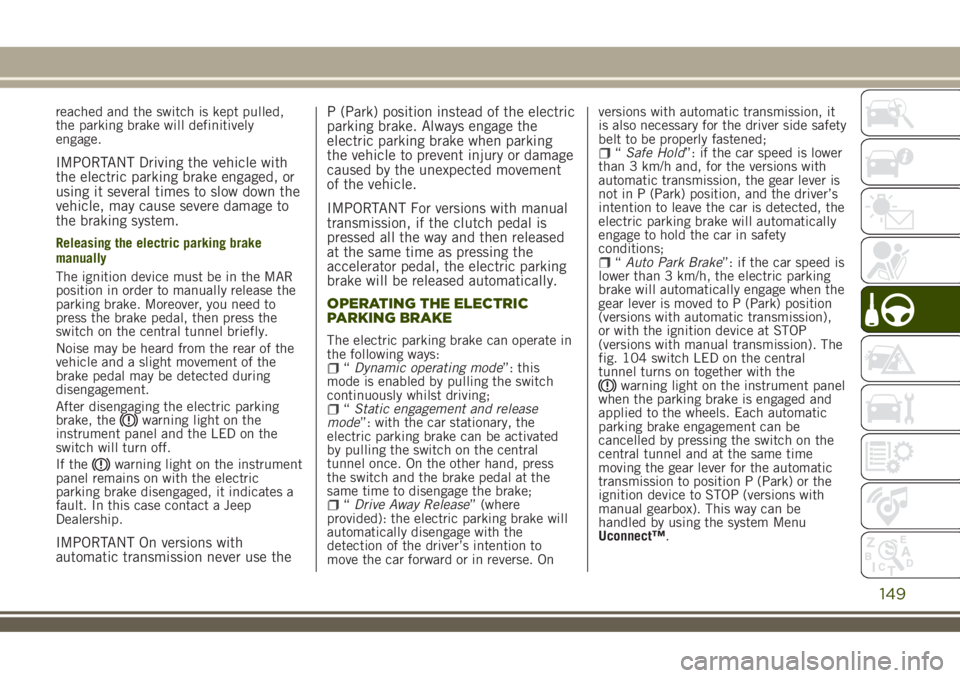
reached and the switch is kept pulled,
the parking brake will definitively
engage.
IMPORTANT Driving the vehicle with
the electric parking brake engaged, or
using it several times to slow down the
vehicle, may cause severe damage to
the braking system.
Releasing the electric parking brake
manually
The ignition device must be in the MAR
position in order to manually release the
parking brake. Moreover, you need to
press the brake pedal, then press the
switch on the central tunnel briefly.
Noise may be heard from the rear of the
vehicle and a slight movement of the
brake pedal may be detected during
disengagement.
After disengaging the electric parking
brake, the
warning light on the
instrument panel and the LED on the
switch will turn off.
If the
warning light on the instrument
panel remains on with the electric
parking brake disengaged, it indicates a
fault. In this case contact a Jeep
Dealership.
IMPORTANT On versions with
automatic transmission never use theP (Park) position instead of the electric
parking brake. Always engage the
electric parking brake when parking
the vehicle to prevent injury or damage
caused by the unexpected movement
of the vehicle.
IMPORTANT For versions with manual
transmission, if the clutch pedal is
pressed all the way and then released
at the same time as pressing the
accelerator pedal, the electric parking
brake will be released automatically.
OPERATING THE ELECTRIC
PARKING BRAKE
The electric parking brake can operate in
the following ways:
“Dynamic operating mode”: this
mode is enabled by pulling the switch
continuously whilst driving;
“Static engagement and release
mode”: with the car stationary, the
electric parking brake can be activated
by pulling the switch on the central
tunnel once. On the other hand, press
the switch and the brake pedal at the
same time to disengage the brake;
“Drive Away Release” (where
provided): the electric parking brake will
automatically disengage with the
detection of the driver’s intention to
move the car forward or in reverse. Onversions with automatic transmission, it
is also necessary for the driver side safety
belt to be properly fastened;
“Safe Hold”: if the car speed is lower
than 3 km/h and, for the versions with
automatic transmission, the gear lever is
not in P (Park) position, and the driver’s
intention to leave the car is detected, the
electric parking brake will automatically
engage to hold the car in safety
conditions;
“Auto Park Brake”: if the car speed is
lower than 3 km/h, the electric parking
brake will automatically engage when the
gear lever is moved to P (Park) position
(versions with automatic transmission),
or with the ignition device at STOP
(versions with manual transmission). The
fig. 104 switch LED on the central
tunnel turns on together with the
warning light on the instrument panel
when the parking brake is engaged and
applied to the wheels. Each automatic
parking brake engagement can be
cancelled by pressing the switch on the
central tunnel and at the same time
moving the gear lever for the automatic
transmission to position P (Park) or the
ignition device to STOP (versions with
manual gearbox). This way can be
handled by using the system Menu
Uconnect™.
149
Page 152 of 356
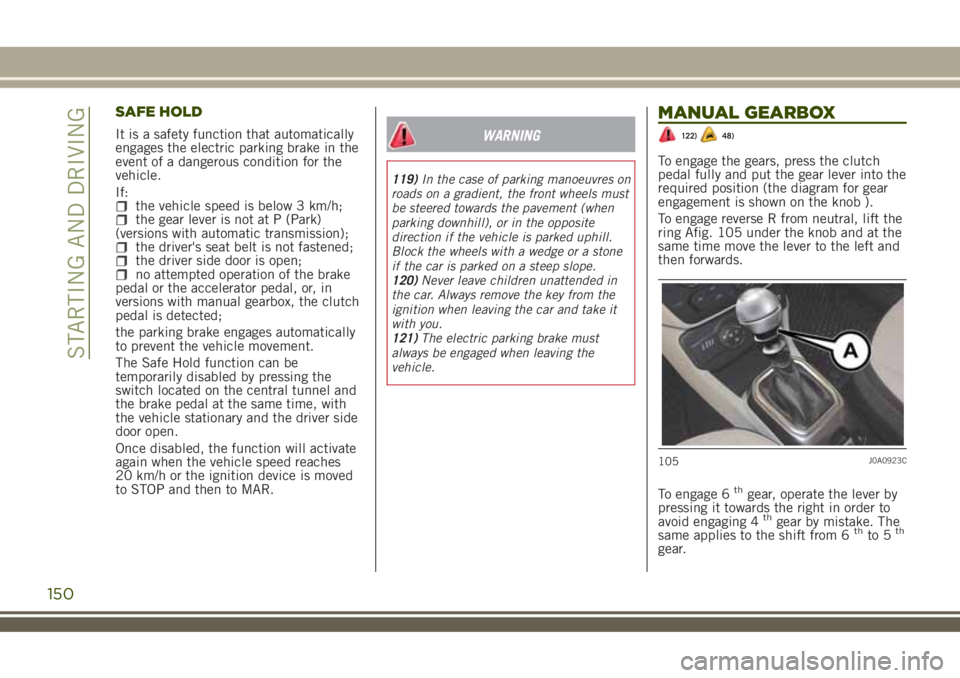
SAFE HOLD
It is a safety function that automatically
engages the electric parking brake in the
event of a dangerous condition for the
vehicle.
If:
the vehicle speed is below 3 km/h;the gear lever is not at P (Park)
(versions with automatic transmission);
the driver's seat belt is not fastened;the driver side door is open;no attempted operation of the brake
pedal or the accelerator pedal, or, in
versions with manual gearbox, the clutch
pedal is detected;
the parking brake engages automatically
to prevent the vehicle movement.
The Safe Hold function can be
temporarily disabled by pressing the
switch located on the central tunnel and
the brake pedal at the same time, with
the vehicle stationary and the driver side
door open.
Once disabled, the function will activate
again when the vehicle speed reaches
20 km/h or the ignition device is moved
to STOP and then to MAR.
WARNING
119)In the case of parking manoeuvres on
roads on a gradient, the front wheels must
be steered towards the pavement (when
parking downhill), or in the opposite
direction if the vehicle is parked uphill.
Block the wheels with a wedge or a stone
if the car is parked on a steep slope.
120)Never leave children unattended in
the car. Always remove the key from the
ignition when leaving the car and take it
with you.
121)The electric parking brake must
always be engaged when leaving the
vehicle.
MANUAL GEARBOX
122)48)
To engage the gears, press the clutch
pedal fully and put the gear lever into the
required position (the diagram for gear
engagement is shown on the knob ).
To engage reverse R from neutral, lift the
ring Afig. 105 under the knob and at the
same time move the lever to the left and
then forwards.
To engage 6
thgear, operate the lever by
pressing it towards the right in order to
avoid engaging 4
thgear by mistake. The
same applies to the shift from 6thto 5th
gear.
105J0A0923C
150
STARTING AND DRIVING
Page 153 of 356
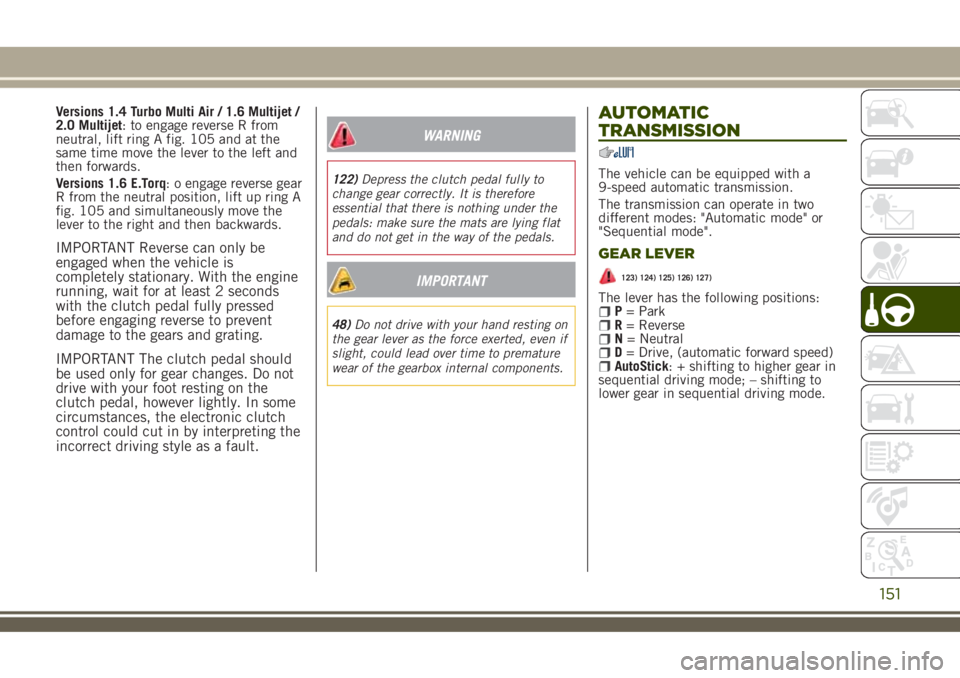
Versions 1.4 Turbo Multi Air / 1.6 Multijet /
2.0 Multijet: to engage reverse R from
neutral, lift ring A fig. 105 and at the
same time move the lever to the left and
then forwards.
Versions 1.6 E.Torq: o engage reverse gear
R from the neutral position, lift up ring A
fig. 105 and simultaneously move the
lever to the right and then backwards.
IMPORTANT Reverse can only be
engaged when the vehicle is
completely stationary. With the engine
running, wait for at least 2 seconds
with the clutch pedal fully pressed
before engaging reverse to prevent
damage to the gears and grating.
IMPORTANT The clutch pedal should
be used only for gear changes. Do not
drive with your foot resting on the
clutch pedal, however lightly. In some
circumstances, the electronic clutch
control could cut in by interpreting the
incorrect driving style as a fault.
WARNING
122)Depress the clutch pedal fully to
change gear correctly. It is therefore
essential that there is nothing under the
pedals: make sure the mats are lying flat
and do not get in the way of the pedals.
IMPORTANT
48)Do not drive with your hand resting on
the gear lever as the force exerted, even if
slight, could lead over time to premature
wear of the gearbox internal components.
AUTOMATIC
TRANSMISSION
The vehicle can be equipped with a
9-speed automatic transmission.
The transmission can operate in two
different modes: "Automatic mode" or
"Sequential mode".
GEAR LEVER
123) 124) 125) 126) 127)
The lever has the following positions:P= ParkR= ReverseN= NeutralD= Drive, (automatic forward speed)AutoStick: + shifting to higher gear in
sequential driving mode; – shifting to
lower gear in sequential driving mode.
151
Page 154 of 356

The gear engaged is shown on the
display.
The lever has a button A fig. 106, which
must be pressed to move the lever to P or
R.
If the transmission is used in "sequential"
mode, which is activated moving the
lever from D (Drive) to the left, the
various positions can be reached towards
+ or –. These positions are unstable.
To exit from the P (Park) position, or to
pass from the N (Neutral) position to the
D (Drive) or R (Reverse) position when
the car is stopped or is moving at a low
speed, the brake pedal must also be
pressed (see "Gear engagement disabling
system with brake engaged" in this
chapter).
IMPORTANT DO NOT accelerate while
shifting from position P (or N) to
another position.
IMPORTANT After selecting a gear,
wait a few seconds before accelerating.
This precaution is particularly
important with a cold engine.
AutoStick - Sequential shifting mode
In the case of frequent gearshiftings (e.g.
when the vehicle is driven with a heavy
load, on slopes, with strong headwind or
when towing heavy trailers), it is
recommended to use the AutoStick
(sequential shifting) mode to select and
keep a lower fixed ratio.
It is possible to shift from position D
(Drive) to the sequential mode regardless
of car speed.
Activation
With gear lever in position D (Drive), to
activate the sequential drive mode, move
the lever to the left (– and + indication of
the panel). The gear engaged will be
shown on the display. Gearshifting is
made by moving the gear lever forwards,
towards symbol – or backwards, towards
symbol +.
Deactivation
Bring the gear lever back in position D
(Drive) ("automatic" driving mode).
TRANSMISSION EMERGENCY
FUNCTION
(where provided)
Transmission operation is constantly
monitored to detect any fault. If a
condition that might damage the
transmission is detected, the
"transmission emergency" function is
activated.
In this condition, the transmission stays
in 4th gear, regardless of the selected
gear.
Positions P (Parking), R (Reverse) e N
(Neutral) still work. Icon
might light
up in the display
In the event of a "transmission
emergency" immediately contact the
nearest Jeep Dealership.
Temporary failure
In the event of a temporary failure, the
transmission correct operation can be
restored for all the forwards gears by
proceeding as follows:
stop the vehicle;bring the transmission lever to P
(Park).
bring the ignition device to STOP;wait for about 10 seconds, then restart
the engine;
select the desired gear: if the problem
is not detected anymore the transmission
correct operation is restored.
106J0A0924C
152
STARTING AND DRIVING
Page 155 of 356
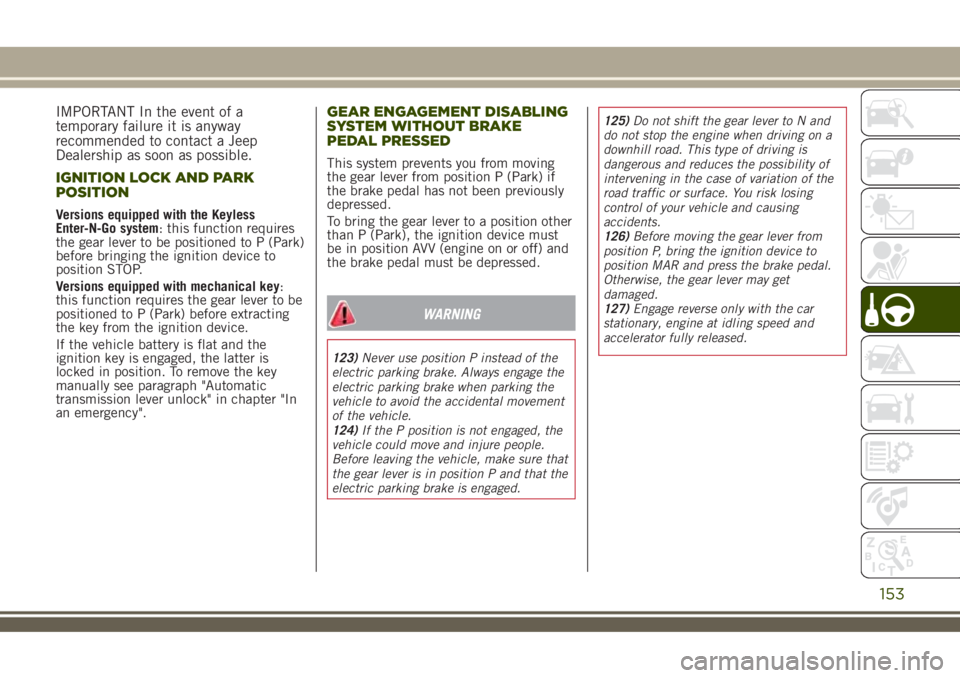
IMPORTANT In the event of a
temporary failure it is anyway
recommended to contact a Jeep
Dealership as soon as possible.
IGNITION LOCK AND PARK
POSITION
Versions equipped with the Keyless
Enter-N-Go system: this function requires
the gear lever to be positioned to P (Park)
before bringing the ignition device to
position STOP.
Versions equipped with mechanical key:
this function requires the gear lever to be
positioned to P (Park) before extracting
the key from the ignition device.
If the vehicle battery is flat and the
ignition key is engaged, the latter is
locked in position. To remove the key
manually see paragraph "Automatic
transmission lever unlock" in chapter "In
an emergency".
GEAR ENGAGEMENT DISABLING
SYSTEM WITHOUT BRAKE
PEDAL PRESSED
This system prevents you from moving
the gear lever from position P (Park) if
the brake pedal has not been previously
depressed.
To bring the gear lever to a position other
than P (Park), the ignition device must
be in position AVV (engine on or off) and
the brake pedal must be depressed.
WARNING
123)Never use position P instead of the
electric parking brake. Always engage the
electric parking brake when parking the
vehicle to avoid the accidental movement
of the vehicle.
124)If the P position is not engaged, the
vehicle could move and injure people.
Before leaving the vehicle, make sure that
the gear lever is in position P and that the
electric parking brake is engaged.125)Do not shift the gear lever to N and
do not stop the engine when driving on a
downhill road. This type of driving is
dangerous and reduces the possibility of
intervening in the case of variation of the
road traffic or surface. You risk losing
control of your vehicle and causing
accidents.
126)Before moving the gear lever from
position P, bring the ignition device to
position MAR and press the brake pedal.
Otherwise, the gear lever may get
damaged.
127)Engage reverse only with the car
stationary, engine at idling speed and
accelerator fully released.
153
Page 156 of 356
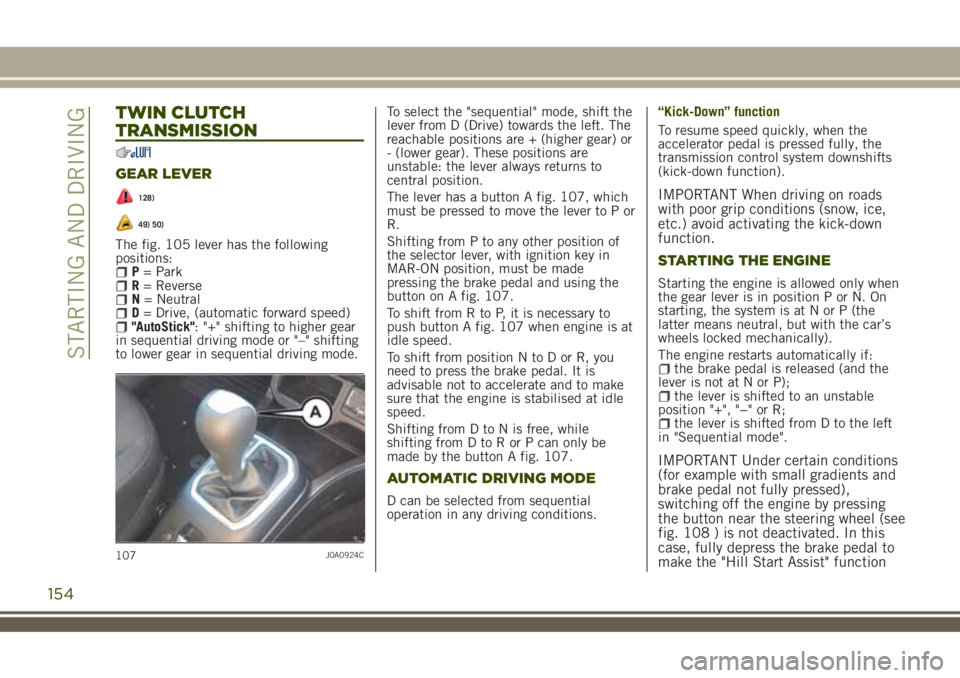
TWIN CLUTCH
TRANSMISSION
GEAR LEVER
128)
49) 50)
The fig. 105 lever has the following
positions:
P= ParkR= ReverseN= NeutralD= Drive, (automatic forward speed)"AutoStick": "+" shifting to higher gear
in sequential driving mode or "–" shifting
to lower gear in sequential driving mode.To select the "sequential" mode, shift the
lever from D (Drive) towards the left. The
reachable positions are + (higher gear) or
- (lower gear). These positions are
unstable: the lever always returns to
central position.
The lever has a button A fig. 107, which
must be pressed to move the lever to P or
R.
Shifting from P to any other position of
the selector lever, with ignition key in
MAR-ON position, must be made
pressing the brake pedal and using the
button on A fig. 107.
To shift from R to P, it is necessary to
push button A fig. 107 when engine is at
idle speed.
To shift from position N to D or R, you
need to press the brake pedal. It is
advisable not to accelerate and to make
sure that the engine is stabilised at idle
speed.
Shifting from D to N is free, while
shifting from D to R or P can only be
made by the button A fig. 107.
AUTOMATIC DRIVING MODE
D can be selected from sequential
operation in any driving conditions.“Kick-Down” function
To resume speed quickly, when the
accelerator pedal is pressed fully, the
transmission control system downshifts
(kick-down function).
IMPORTANT When driving on roads
with poor grip conditions (snow, ice,
etc.) avoid activating the kick-down
function.
STARTING THE ENGINE
Starting the engine is allowed only when
the gear lever is in position P or N. On
starting, the system is at N or P (the
latter means neutral, but with the car’s
wheels locked mechanically).
The engine restarts automatically if:
the brake pedal is released (and the
lever is not at N or P);
the lever is shifted to an unstable
position "+", "−" or R;
the lever is shifted from D to the left
in "Sequential mode".
IMPORTANT Under certain conditions
(for example with small gradients and
brake pedal not fully pressed),
switching off the engine by pressing
the button near the steering wheel (see
fig. 108 ) is not deactivated. In this
case, fully depress the brake pedal to
make the "Hill Start Assist" function
107J0A0924C
154
STARTING AND DRIVING
Page 157 of 356
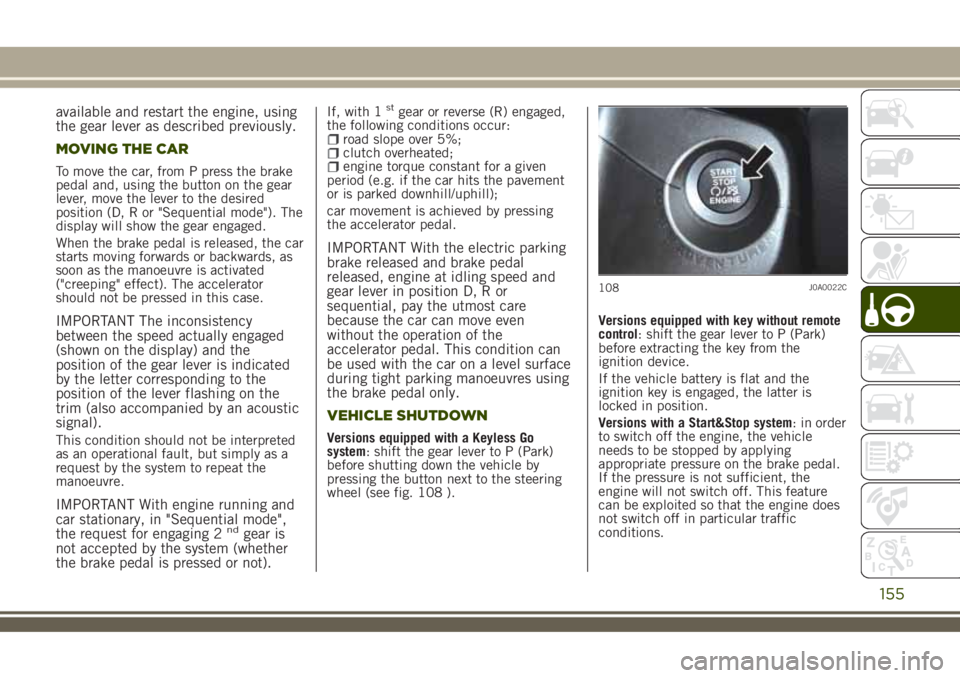
available and restart the engine, using
the gear lever as described previously.
MOVING THE CAR
To move the car, from P press the brake
pedal and, using the button on the gear
lever, move the lever to the desired
position (D, R or "Sequential mode"). The
display will show the gear engaged.
When the brake pedal is released, the car
starts moving forwards or backwards, as
soon as the manoeuvre is activated
("creeping" effect). The accelerator
should not be pressed in this case.
IMPORTANT The inconsistency
between the speed actually engaged
(shown on the display) and the
position of the gear lever is indicated
by the letter corresponding to the
position of the lever flashing on the
trim (also accompanied by an acoustic
signal).
This condition should not be interpreted
as an operational fault, but simply as a
request by the system to repeat the
manoeuvre.
IMPORTANT With engine running and
car stationary, in "Sequential mode",
the request for engaging 2
ndgear is
not accepted by the system (whether
the brake pedal is pressed or not).
If, with 1stgear or reverse (R) engaged,
the following conditions occur:
road slope over 5%;clutch overheated;engine torque constant for a given
period (e.g. if the car hits the pavement
or is parked downhill/uphill);
car movement is achieved by pressing
the accelerator pedal.
IMPORTANT With the electric parking
brake released and brake pedal
released, engine at idling speed and
gear lever in position D, R or
sequential, pay the utmost care
because the car can move even
without the operation of the
accelerator pedal. This condition can
be used with the car on a level surface
during tight parking manoeuvres using
the brake pedal only.
VEHICLE SHUTDOWN
Versions equipped with a Keyless Go
system: shift the gear lever to P (Park)
before shutting down the vehicle by
pressing the button next to the steering
wheel (see fig. 108 ).Versions equipped with key without remote
control: shift the gear lever to P (Park)
before extracting the key from the
ignition device.
If the vehicle battery is flat and the
ignition key is engaged, the latter is
locked in position.
Versions with a Start&Stop system: in order
to switch off the engine, the vehicle
needs to be stopped by applying
appropriate pressure on the brake pedal.
If the pressure is not sufficient, the
engine will not switch off. This feature
can be exploited so that the engine does
not switch off in particular traffic
conditions.
108J0A0022C
155
Page 158 of 356
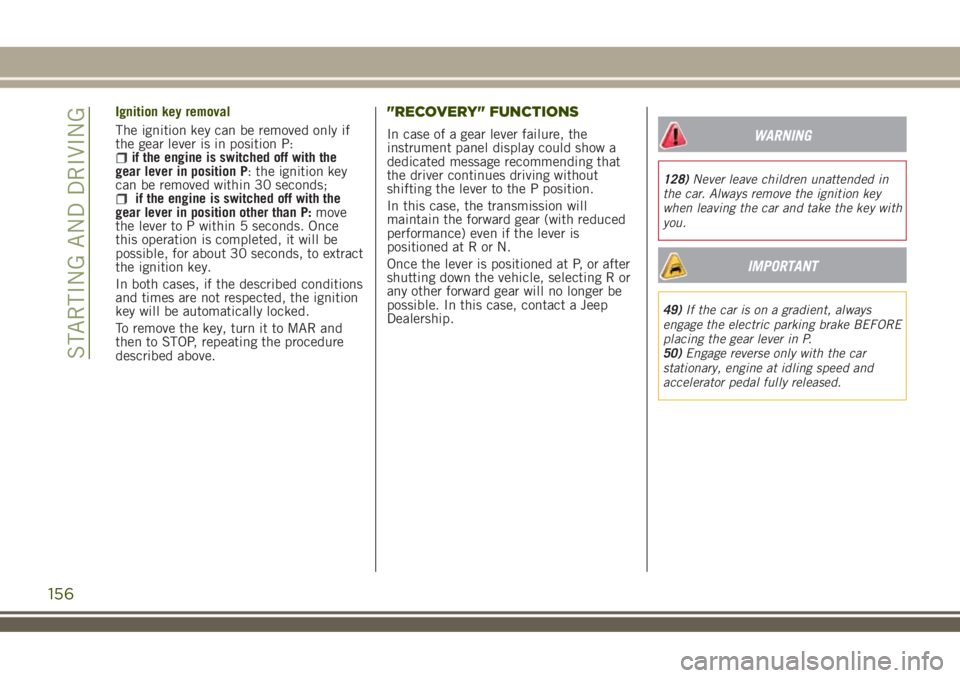
Ignition key removal
The ignition key can be removed only if
the gear lever is in position P:
if the engine is switched off with the
gear lever in position P: the ignition key
can be removed within 30 seconds;
if the engine is switched off with the
gear lever in position other than P:move
the lever to P within 5 seconds. Once
this operation is completed, it will be
possible, for about 30 seconds, to extract
the ignition key.
In both cases, if the described conditions
and times are not respected, the ignition
key will be automatically locked.
To remove the key, turn it to MAR and
then to STOP, repeating the procedure
described above.
"RECOVERY" FUNCTIONS
In case of a gear lever failure, the
instrument panel display could show a
dedicated message recommending that
the driver continues driving without
shifting the lever to the P position.
In this case, the transmission will
maintain the forward gear (with reduced
performance) even if the lever is
positioned at R or N.
Once the lever is positioned at P, or after
shutting down the vehicle, selecting R or
any other forward gear will no longer be
possible. In this case, contact a Jeep
Dealership.WARNING
128)Never leave children unattended in
the car. Always remove the ignition key
when leaving the car and take the key with
you.
IMPORTANT
49)If the car is on a gradient, always
engage the electric parking brake BEFORE
placing the gear lever in P.
50)Engage reverse only with the car
stationary, engine at idling speed and
accelerator pedal fully released.
156
STARTING AND DRIVING
Page 159 of 356
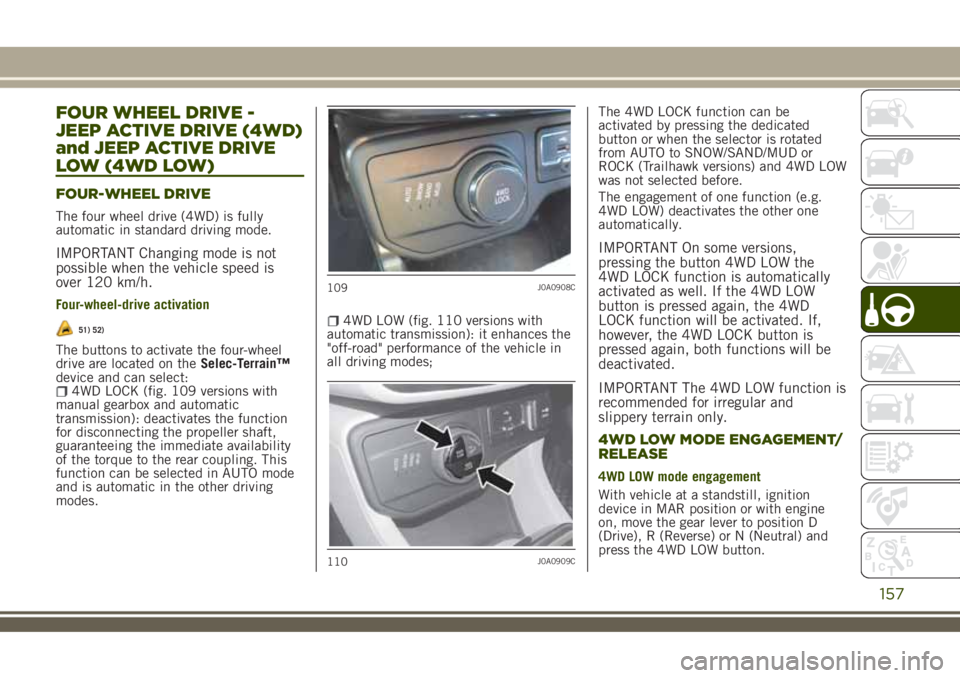
FOUR WHEEL DRIVE -
JEEP ACTIVE DRIVE (4WD)
and JEEP ACTIVE DRIVE
LOW (4WD LOW)
FOUR-WHEEL DRIVE
The four wheel drive (4WD) is fully
automatic in standard driving mode.
IMPORTANT Changing mode is not
possible when the vehicle speed is
over 120 km/h.
Four-wheel-drive activation
51) 52)
The buttons to activate the four-wheel
drive are located on theSelec-Terrain™
device and can select:
4WD LOCK (fig. 109 versions with
manual gearbox and automatic
transmission): deactivates the function
for disconnecting the propeller shaft,
guaranteeing the immediate availability
of the torque to the rear coupling. This
function can be selected in AUTO mode
and is automatic in the other driving
modes.
4WD LOW (fig. 110 versions with
automatic transmission): it enhances the
"off-road" performance of the vehicle in
all driving modes;The 4WD LOCK function can be
activated by pressing the dedicated
button or when the selector is rotated
from AUTO to SNOW/SAND/MUD or
ROCK (Trailhawk versions) and 4WD LOW
was not selected before.
The engagement of one function (e.g.
4WD LOW) deactivates the other one
automatically.
IMPORTANT On some versions,
pressing the button 4WD LOW the
4WD LOCK function is automatically
activated as well. If the 4WD LOW
button is pressed again, the 4WD
LOCK function will be activated. If,
however, the 4WD LOCK button is
pressed again, both functions will be
deactivated.
IMPORTANT The 4WD LOW function is
recommended for irregular and
slippery terrain only.
4WD LOW MODE ENGAGEMENT/
RELEASE
4WD LOW mode engagement
With vehicle at a standstill, ignition
device in MAR position or with engine
on, move the gear lever to position D
(Drive), R (Reverse) or N (Neutral) and
press the 4WD LOW button.
109J0A0908C
110J0A0909C
157
Page 160 of 356
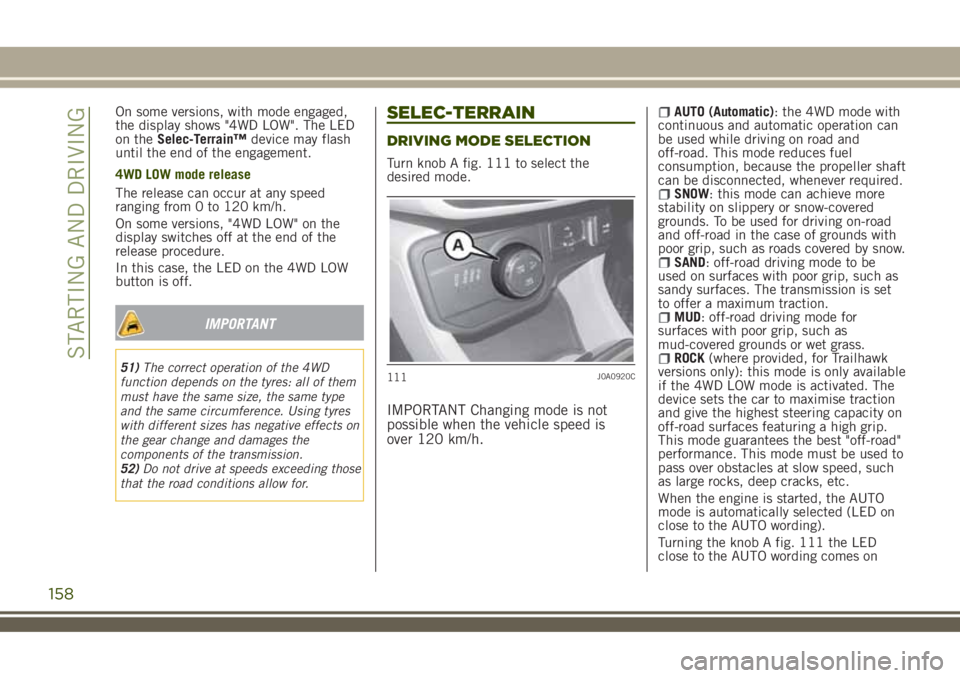
On some versions, with mode engaged,
the display shows "4WD LOW". The LED
on theSelec-Terrain™device may flash
until the end of the engagement.
4WD LOW mode release
The release can occur at any speed
ranging from 0 to 120 km/h.
On some versions, "4WD LOW" on the
display switches off at the end of the
release procedure.
In this case, the LED on the 4WD LOW
button is off.
IMPORTANT
51)The correct operation of the 4WD
function depends on the tyres: all of them
must have the same size, the same type
and the same circumference. Using tyres
with different sizes has negative effects on
the gear change and damages the
components of the transmission.
52)Do not drive at speeds exceeding those
that the road conditions allow for.
SELEC-TERRAIN
DRIVING MODE SELECTION
Turn knob A fig. 111 to select the
desired mode.
IMPORTANT Changing mode is not
possible when the vehicle speed is
over 120 km/h.
AUTO (Automatic): the 4WD mode with
continuous and automatic operation can
be used while driving on road and
off-road. This mode reduces fuel
consumption, because the propeller shaft
can be disconnected, whenever required.
SNOW: this mode can achieve more
stability on slippery or snow-covered
grounds. To be used for driving on-road
and off-road in the case of grounds with
poor grip, such as roads covered by snow.
SAND: off-road driving mode to be
used on surfaces with poor grip, such as
sandy surfaces. The transmission is set
to offer a maximum traction.
MUD: off-road driving mode for
surfaces with poor grip, such as
mud-covered grounds or wet grass.
ROCK(where provided, for Trailhawk
versions only): this mode is only available
if the 4WD LOW mode is activated. The
device sets the car to maximise traction
and give the highest steering capacity on
off-road surfaces featuring a high grip.
This mode guarantees the best "off-road"
performance. This mode must be used to
pass over obstacles at slow speed, such
as large rocks, deep cracks, etc.
When the engine is started, the AUTO
mode is automatically selected (LED on
close to the AUTO wording).
Turning the knob A fig. 111 the LED
close to the AUTO wording comes on
111J0A0920C
158
STARTING AND DRIVING